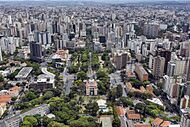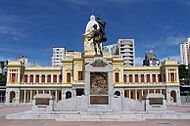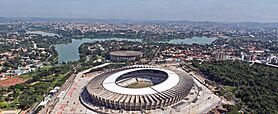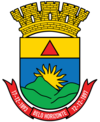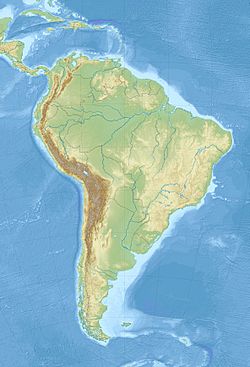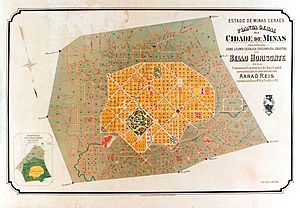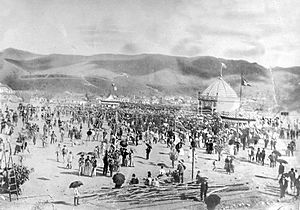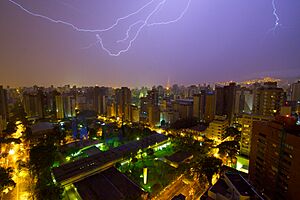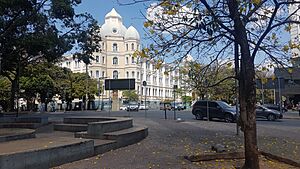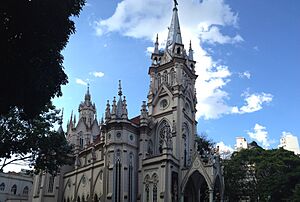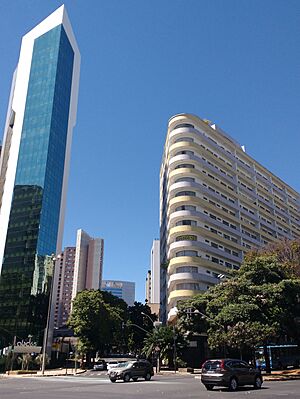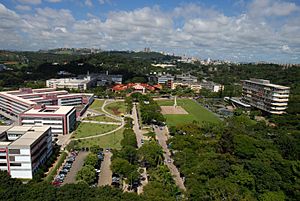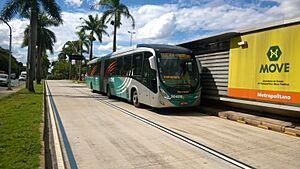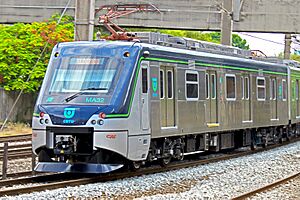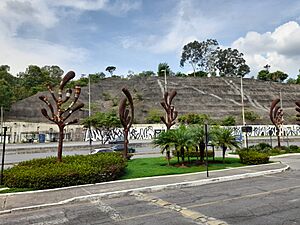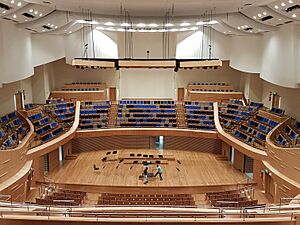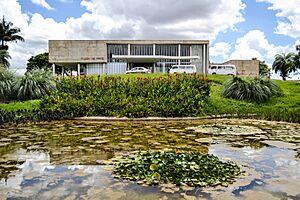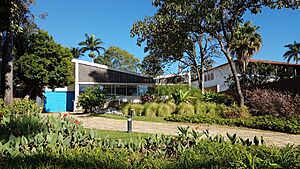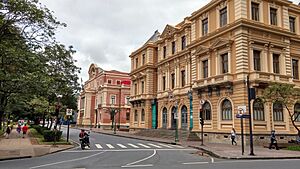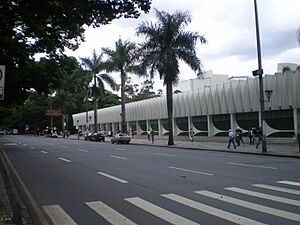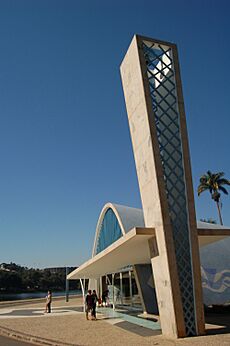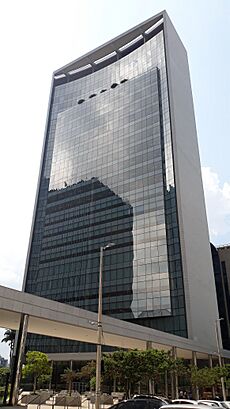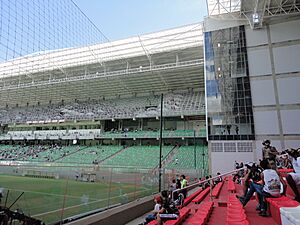Belo Horizonte facts for kids
Quick facts for kids
Belo Horizonte
|
|||
|---|---|---|---|
|
Municipality
|
|||
| Municipality of Belo Horizonte | |||
|
Aerial view of Praça da Liberdade
Church of Saint Francis of Assisi
Municipal Park
Praça Sete de Setembro
Monument to Civilization in Minas, at Rui Barbosa Square
Afonso Pena Avenue
Mineirão Stadium and Lake Pampulha
|
|||
|
|||
Nicknames:
|
|||
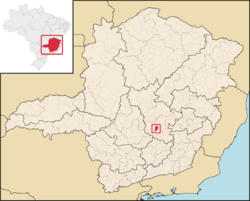
Location in Minas Gerais
|
|||
| Country | |||
| State | Minas Gerais | ||
| Region | Southeast | ||
| Intermediate Region | Belo Horizonte | ||
| Immediate Region | Belo Horizonte | ||
| Founded | 12 December 1897 | ||
| Government | |||
| • Body | Municipal Chamber | ||
| Area | |||
| • Municipality | 331.354 km2 (127.936 sq mi) | ||
| • Urban | 282.3 km2 (109.0 sq mi) | ||
| • Metro | 9,459.1 km2 (3,652.2 sq mi) | ||
| Elevation | 852 m (2,795 ft) | ||
| Population
(2022)
|
|||
| • Municipality | 2,315,560 | ||
| • Rank | 6th | ||
| • Density | 6,988.176/km2 (18,099.29/sq mi) | ||
| • Metro | 6,006,887 (3rd) | ||
| • Metro density | 635/km2 (1,640/sq mi) | ||
| Demonym(s) | belo-horizontino(a) | ||
| GDP (PPP, constant 2015 values) | |||
| • Year | 2023 | ||
| • Total (Metro) | $84.8 billion | ||
| • Per capita | $15,900 | ||
| Time zone | UTC−3 (BRT) | ||
| Postal code |
30000-001 to 31999-999
|
||
| Area code | +55 31 | ||
| HDI (2010) | 0.810 very high | ||
| Major airport | Belo Horizonte International Airport | ||
| Federal Highways | |||
| State highways | |||
| Passenger rail | Vitória-Minas Railway | ||
| Commuter rail | |||
Belo Horizonte is a large city in Brazil. It is the sixth-largest city in the country, with about 2.3 million people. Its wider metropolitan area is the third largest in Brazil, home to 6 million people. This makes it one of the biggest cities in South America. Belo Horizonte is the capital of Minas Gerais state, which is the second most populated state in Brazil. It was the first modern city in Brazil to be carefully planned.
The area was first settled in the early 1700s. However, the city we know today was planned and built in the 1890s. It was designed to replace Ouro Preto as the capital of Minas Gerais. The city mixes old and new buildings. It has many famous Brazilian architectural designs, especially the Pampulha Complex. When planning the city, the designers were inspired by Washington, D.C.. Belo Horizonte has won international awards for its programs in city renewal and food security.
The city is built on several hills and is surrounded by mountains. There are many large parks around Belo Horizonte. Mangabeiras Park is southeast of the city center. It offers great views of the city. This park covers 2.35 square kilometers, with 0.9 square kilometers of native forest. The Jambreiro Woods nature reserve is 912 hectares. It has plants typical of the Atlantic Forest. Over 100 bird species and 10 mammal species live there.
Belo Horizonte was a host city for the 1950 FIFA World Cup and the 2014 FIFA World Cup. It also hosted games for the 2013 FIFA Confederations Cup. Plus, it was a venue for the football tournament during the 2016 Summer Olympics.
Contents
History of Belo Horizonte
Early Settlement and Growth
Belo Horizonte began as a small village. It was founded in 1701 by João Leite da Silva Ortiz, an explorer from São Paulo. He started a farm called "Curral d'el Rey," which means "King's Corral" in old Portuguese.
The farm became very successful. This encouraged many people from nearby areas to move there. Soon, Curral d'el Rey grew into a village surrounded by farms.
Travelers passing through the village also helped it grow. They often stopped at a small wooden chapel to pray for a safe journey. This chapel was called Capela da Nossa Senhora da Boa Viagem, meaning "Chapel of Our Lady of the Good Journey." Later, a new church was built in its place, which became the city's cathedral.
Becoming a Modern Capital
The old capital of Minas Gerais was Ouro Preto. It was a symbol of the old Brazilian Empire and its mining industry. But after Brazil became a republic in 1889, leaders wanted a new, modern capital.
In 1893, Curral Del Rey was chosen for its good climate and location. It was renamed Cidade de Minas, or City of Minas.
Aarão Reis, a city planner, designed the new city. It was the second planned city in Brazil. Cidade de Minas officially opened in 1897. The government encouraged people to move there by offering free land and money to build homes. The city's downtown streets were named after Brazilian states and native tribes.
In 1906, the city's name was changed to Belo Horizonte. The city started to grow quickly with new factories and businesses. The original plan did not allow workers to live in the main city area. This led to fast growth outside the planned center.
In the 1940s, a famous architect named Oscar Niemeyer designed the Pampulha neighborhood. This project was supported by the mayor, Juscelino Kubitschek. These two men helped shape the city with its wide avenues, large lakes, and modern buildings.
Belo Horizonte is now a major center for business and technology. Google has a research center here. The city is also known for its music, literature, and architecture.
Geography and Climate
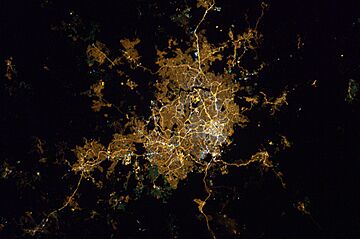
Greater Belo Horizonte
"Greater Belo Horizonte" refers to the larger metropolitan area. This area includes 34 different towns and cities. It has about six million people.
The city of Belo Horizonte is connected to nearby towns like Contagem and Nova Lima. These areas form one large urban space. Belo Horizonte is surrounded by other municipalities.
Landscape and Parks
Belo Horizonte is built on a varied landscape. It has many hills and is surrounded by mountains. The highest point in the city is in the Serra do Curral (Corral Ridge), reaching 1,538 meters.
The city has several important parks. The Zoo-Botanical Foundation manages the Zoo. It has nearly 900 animals from 200 species. It also has the first public butterfly sanctuary in South America.
Pampulha Ecological Park is a large green area. It offers programs about nature and culture. The city also has parts of the Serra do Rola-Moça State Park. This park helps protect local plants and animals.
Climate of Belo Horizonte
Belo Horizonte is in the tropical zone. Its yearly temperatures usually range from 9 to 35 degrees Celsius. The city has a tropical savanna climate. This means it has humid and warm summers, and dry and mild winters.
Because of its elevation (852 meters), Belo Horizonte is cooler than many other cities nearby. The climate is mild throughout the year. Temperatures usually stay between 11 and 31 degrees Celsius. The average temperature is 22 degrees Celsius. Winters are dry and sunny, while summers are rainy.
People and Culture
Population and Diversity
In 2022, Belo Horizonte had 2,315,560 people. The population is diverse. About 43.6% are White, 42.6% are Multiracial (Pardo), and 13.5% are Black. There are also small numbers of Asian and Indigenous people.
The city has a notable Italian influence. About 30% of the people have some Italian background. Other groups include those of German, Spanish, French, and Syrian-Lebanese descent.
Community Initiatives
Belo Horizonte is known for its programs that help its citizens. In 1993, the city started programs based on the "right to food." For example, they created farmers' markets for direct sales. They also shared market prices across the city. These efforts helped reduce the infant mortality rate by 50% in ten years.
The city also has a project called Vila Viva ("Living Village"). This project improves the poorest areas, called favelas. It moves families from dangerous areas but keeps them in their neighborhoods. It also paves roads for public transport and services. Most of the work is done by local people, which helps reduce unemployment.
Religion in Belo Horizonte
Most people in Belo Horizonte are Catholic. About 59.87% of the population follows this religion. Protestants make up 25.06% of the population. About 8.02% of people have no religion. There are also followers of Spiritism and other faiths.
Economy of Belo Horizonte
Belo Horizonte is a major economic center in Brazil. Many large companies have offices here, including Google and Deloitte. The service industry is very important. It makes up 85% of the city's economy.
Belo Horizonte also has a strong industrial sector. It is known for its steel and metal industries. This is because Minas Gerais state has many minerals, especially iron ore.
Big companies like FIAT and Arcelor have factories nearby. The city is also home to major Brazilian companies like Gerdau and CEMIG.
The city is becoming a leader in Information Technology and Biotechnology. The number of jobs in the tech sector is growing fast. Belo Horizonte's metropolitan area has 16% of Brazil's biotechnology companies. The city is also known for its research in Biodiesel fuel.
Belo Horizonte is also a hub for business tourism. This means many people visit the city for conferences and business events.
Education in Belo Horizonte
Belo Horizonte has many excellent universities and colleges. Some of the main ones include:
- Centro Federal de Educação Tecnológica de Minas Gerais (CEFET-MG)
- Pontifícia Universidade Católica de Minas Gerais (PUC-MG)
- Universidade do Estado de Minas Gerais (UEMG)
- Universidade Federal de Minas Gerais (UFMG)
- Universidade FUMEC
Transportation in Belo Horizonte
Airports
Belo Horizonte has three airports:
- Tancredo Neves International Airport handles flights within Brazil and to other countries. It is about 38 kilometers from the city.
- Belo Horizonte/Pampulha - Carlos Drummond de Andrade Airport is for domestic flights.
- Carlos Prates Airport is for smaller, private planes.
Roads and Highways
The city is well-connected by a network of highways. These roads link Belo Horizonte to other parts of Minas Gerais and Brazil.
- BR-040 connects Belo Horizonte to Rio de Janeiro and Brasília.
- BR-262 crosses Minas Gerais from west to east.
- BR-381 is an important highway to São Paulo.
- MG-010 is a state highway that leads to the international airport.
The city also has a "beltway" called Anel Rodoviário. It helps traffic bypass the city center.
Public Transport
Belo Horizonte has a large bus system managed by BHTRANS. There are plans to expand the bus system. This includes building special bus lanes to avoid traffic.
The Belo Horizonte Metro started in the late 1970s. It has one line with 19 stations. It carries over 160,000 people daily. There are plans to add more lines in the future.
On average, people in Belo Horizonte spend 85 minutes commuting by public transport on a weekday.
Culture and Arts
Theatre and Dance
Every two years, Belo Horizonte hosts FIT BH, the International Theater Festival. Artists from Brazil and around the world come to perform. The festival includes street and stage shows, workshops, and talks.
The Annual Campaign for the Popularisation of Theatre happens every January and February. It offers many plays at affordable prices.
Grupo Corpo, a famous contemporary dance group, started in Belo Horizonte in 1975. The city also has the Centro Mineiro de Danças Clássicas school.
Music Scene
The Clube da Esquina is a very important music movement from Belo Horizonte. It started in the 1960s. Its members, like Milton Nascimento, became very famous in Brazil and worldwide.
Belo Horizonte is also known as the "Brazilian Capital of Metal music." Many heavy metal bands, like Sepultura and Sarcófago, started here. Other famous rock bands from the city include Jota Quest and Skank.
Museums and Cultural Spaces
Belo Horizonte has many museums. These include the Mineiro Museum, the Abílio Barreto Historic Museum, and the Pampulha Art Museum. The puppet theater group Giramundo also has a museum here.
The Circuito Cultural Praça da Liberdade is a large cultural area in the city center. It has eleven museums and cultural spaces. These include the Minas Gerais Public Archive and the Minas Gerais Memorial. This area used to house government offices. Now, many of these old buildings are being turned into museums.
The Natural History Museum and Botanical Garden has a unique collection of folk art. It includes the Nativity of Pipiripau, with 586 figures telling the story of Jesus. This museum also has a large green area for visitors to explore nature.
The Palácio das Artes, opened in 1970, has theaters, art galleries, and a movie theater. The Pampulha Art Museum is located by Pampulha Lake. It was designed by Oscar Niemeyer and used to be a casino. It has a collection of 1,600 artworks.
Architecture and Landmarks
Belo Horizonte has many important buildings. The Pampulha district has famous examples of Brazilian contemporary architecture. Architects like Oscar Niemeyer and landscaper Burle Marx created modern designs here. These designs later influenced the building of Brasilia.
The Pampulha area includes the Mineirão stadium and the São Francisco de Assis Church. The Universidade Federal de Minas Gerais campus also has important buildings.
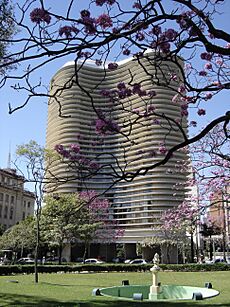
In the city center, you can find the São José Church and Praça da Estação (Station Square). This old train station is now the Museum of Arts and Workmanship. The Municipal Park and Sete de Setembro Square are also popular spots.
The Savassi district is known for its restaurants and nightlife. It has landmarks like Praça da Liberdade (Liberty Square). This square is surrounded by beautiful buildings, including the former governor's office.
Praça do Papa (Pope's Square) offers a great view of the city. It is named after John Paul II's visit in 1980. Nearby, Mangabeiras Park has lots of wildlife. On Sundays, Afonso Pena Avenue hosts a large open-air market called Feira Hippie.
Food and Drink
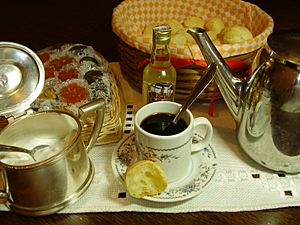
The local food of Minas Gerais and the drink cachaça are very popular. Belo Horizonte is known as the "capital of neighborhood bars."
Every year, the city hosts the Comida di Buteco festival. Bars compete to see who has the best appetizers. This festival is so popular that it now happens in many other cities in Brazil.
The Savassi, Lourdes, Mercado Central, Santa Tereza, and Pampulha areas have most of the city's restaurants and bars.
Sports in Belo Horizonte
Football (Soccer)
Like in the rest of Brazil, football is the most popular sport. Belo Horizonte has three major teams: Atlético Mineiro, Cruzeiro, and América Mineiro.
The city is home to one of the world's biggest football stadiums, the Mineirão. It opened in 1965. The older Independência Stadium hosted a game in the FIFA World Cup 1950. In that game, the United States beat England 1–0.
Atlético Mineiro built its own stadium, Arena MRV. Construction started in 2020 and finished in 2023. It hosted its first official match in August 2023. The stadium has a capacity of over 46,000 people.
Mineirão stadium was renovated for the 2014 FIFA World Cup. It hosted six matches during the World Cup. It also hosted games for the 2013 FIFA Confederations Cup and the Olympic football tournament in 2016.
| Club | League | Venue | Established (team) |
|---|---|---|---|
| Atlético Mineiro | Série A | Arena MRV
46.000 (44.048 record) |
1908 |
| Cruzeiro | Série A | Mineirão
61.846 (132,834 record) |
1921 |
| América Mineiro | Série B | Independência Stadium
23,018 (32,721 record) |
1912 |
Belo Horizonte also has many fans for volleyball matches. These games are played at Mineirinho or Minas Tênis Clube.
Other Sports
Belo Horizonte is home to famous tennis players. These include Marcelo Melo, a French Open men's doubles champion. Also, Bruno Soares, an Australian Open men's and mixed doubles champion.
The Minas Tênis Clube is a multi-sport club. It has teams in basketball, futsal, and volleyball.
International Connections
Belo Horizonte has "sister city" relationships with many cities around the world. These connections help promote cultural exchange and friendship.
 Austin, United States (1965-1991)
Austin, United States (1965-1991) Luanda, Angola (1968)
Luanda, Angola (1968) Zahlé, Lebanon (1974)
Zahlé, Lebanon (1974) Granada, Spain (1975)
Granada, Spain (1975) Porto, Portugal (1986)
Porto, Portugal (1986) Minsk, Belarus (1987)
Minsk, Belarus (1987) Havana, Cuba (1995)
Havana, Cuba (1995) Bethlehem, Palestine (1999)
Bethlehem, Palestine (1999) Homs, Syria (2001)
Homs, Syria (2001) Masaya, Nicaragua (2002)
Masaya, Nicaragua (2002) Fort Lauderdale, United States (2003)
Fort Lauderdale, United States (2003) Tripoli, Libya (2003)
Tripoli, Libya (2003) Cuenca, Ecuador (2004)
Cuenca, Ecuador (2004) Tegucigalpa, Honduras (2004)
Tegucigalpa, Honduras (2004) Newark, United States (2006)
Newark, United States (2006) Lagos, Nigeria (2011)
Lagos, Nigeria (2011)
Notable People
- Ricardo Viana Vargas (born 1972), engineer
- Fernando Sabino
Images for kids
See also
 In Spanish: Belo Horizonte para niños
In Spanish: Belo Horizonte para niños


